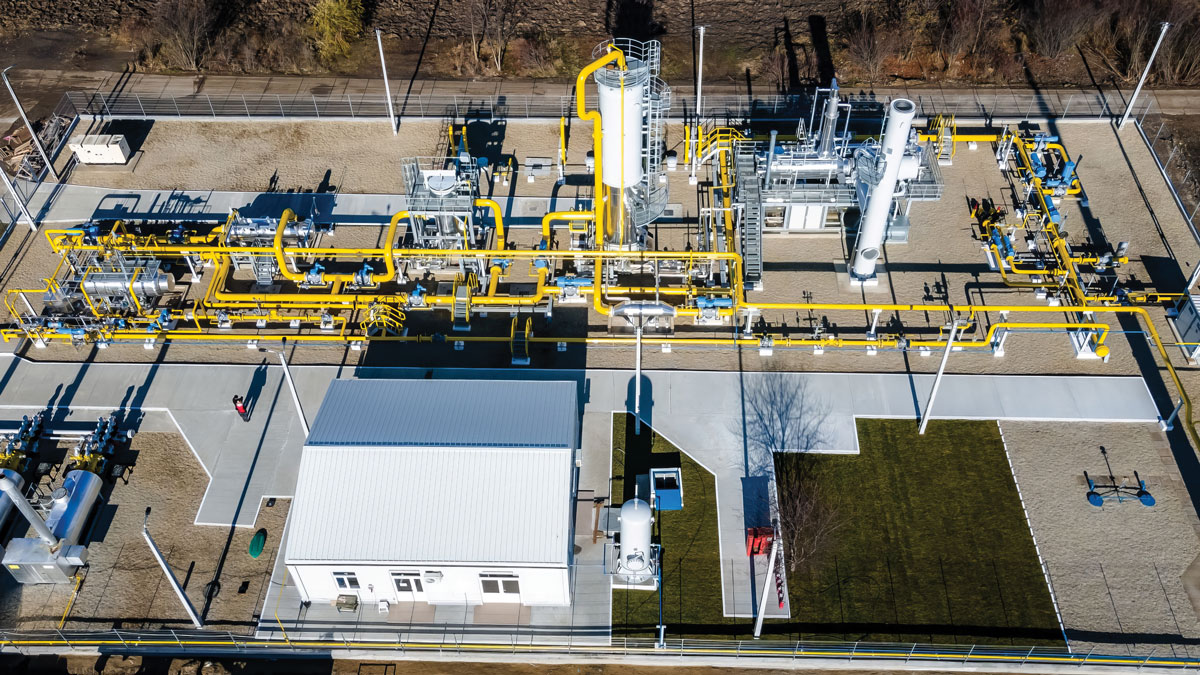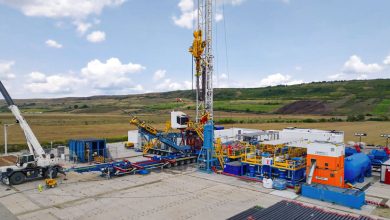Strategic Sector in Romania: Underground Gas Storage
Underground gas storage (UGS) facilities are strategic infrastructure in which natural gas reserves are kept in order to match supply and demand and meet consumption peaks that may occur throughout the year due to seasonal variations and other factors. Typical storage facilities include depleted oil and gas reservoirs, depleted aquifers, underground salt caverns, etc.
The storage of natural gas is important both to provide strategic reserves and to meet peak load demands. Also, subsurface energy storage plays a critical role in facilitating the transition to sustainable energy sources.
As many renewable energy generation methods, such as wind and solar power, exhibit fluctuations over short periods and across peak and off-peak demand seasons, reliable energy provision relies on effective energy storage solutions. That’s why underground natural gas storage will certainly gain increasing importance as the energy transition progresses. This represents one of the main means to achieve energy security, a major dimension of the energy trilemma.
The main operator of underground storage of natural gas in Romania is Depogaz, a modern company with a rich experience in this area. It holds a share of approximately 90.54% of the total active storage capacity of Romania.
Energy security, as a fundamental component of the economic security of the state, means solid sources of energy supply and steady supply of energy at affordable prices. A key element in ensuring a high degree of energy security is the ability to store energy when the demand for natural gas is lower than domestic production or when the natural gas market is favourable.
The security of natural gas supply is the foundation of any energy policy – an interruption of natural gas supplies has major consequences on the economies of the EU member states, and in order to strengthen their security, EU countries need to diversify their energy carriers and sources.
Romania’s Energy Strategy 2020-2030 with the perspective of 2050 responds to the requirements of the European energy policy in terms of ensuring security of gas supply and increasing the flexibility of the national gas transmission network, in close connection with underground storage, as the main pipelines are connected to gas storage facilities.
Underground gas storage plays a key role in security of gas supply by meeting seasonal peaks in demand and mitigating the gap between supply and demand. It contributes to creating a balance between consumption and domestic production or imports of natural gas and to increasing the efficiency of the national gas transmission network.
The natural gas underground storage facilities operated by Depogaz have the role of covering consumption peaks and the fluctuating demand regime, of operative balancing of the functional parameters of the national natural gas transmission system (pressures, flows) through main pipelines and also of control of deliveries in extreme situations (source shutdowns, accidents, etc.). At the same time, the underground storage of natural gas has the strategic role of ensuring the supply of natural gas from the underground storage sites, in cases of force majeure (calamities, earthquakes and other unforeseen events).
In extreme situations, supplies from underground natural gas storage facilities can cover approximately 40% of Romania’s daily natural gas demand.
In Romania, underground natural gas storage is developed in depleted natural gas fields which, following extensive scientific research studies, have been shown to meet the technical criteria required for conversion to underground storage facilities and have demonstrated superior performance and high storage capacity.
Depogaz holds a license for the operation of 5 underground natural gas storage facilities, developed in depleted gas fields, whose cumulated storage capacity rises up to 2,870 million Scm/cycle, the facilities being positioned in various geographical areas of Romania, as follows:
- Bilciuresti (Dambovita County) – active capacity: 1310 million Scm/cycle
- Urziceni (Ialomita County) – active capacity: 360 million Scm/cycle
- Balaceanca (Ilfov County) – active capacity: 50 million Scm/cycle
- Sarmasel (Mures County) – active capacity: 900 million Scm/cycle
- Ghercesti (Dolj County) – active capacity: 250 million Scm/cycle.
After carrying out tests to increase the active capacity in the Sarmasel UGS and testing the current gauge of wells in Ghercesti UGS, Depogaz has reached the operating stage objective of a surplus of current storage capacity, for the current storage cycle 2023-2024, of approximately 100 million Scm/cycle, used to cover the storage requests received from customers in the market. In the given context, Depogaz will take the necessary steps to include this increase in the total active storage capacity that it will operate in the future storage cycles.
At national level, according to statistics of the last 5 years, the ratio between the volume of gas stored and the annual consumption is around 22%, in the middle of the ranking of values recorded in European countries.
The contribution of storage activity to ensuring the volumes of gas required for annual consumption can be extended by increasing the technical performance of underground storage facilities, a feasible objective as long as the conditions for storage filling levels are fulfilled and the technical parameters in order to increase the volumes of gas extracted daily during the withdrawal cycle are improved.
According to the Preventive Action Plan on measures to guarantee the security of natural gas supply in Romania, the storage investment projects promoted by Depogaz for the period 2021-2030 include the following actions:
- Investments in the modernisation of UGS to increase the storage capacity and the daily delivery capacity of natural gas
- Increasing flexibility of UGS operation for the injection and cycles by promoting alternative operational solutions.
5 development projects
Depogaz promotes five development projects, modelled in relation to the requirements of the European gas market and included in TYNDP 2022.
- ‘Daily withdrawal capacity increase – Bilciuresti UGS – Modernising the infrastructure of the natural gas storage system’ (ENTSOG code: UGS – F- 311; PIC number: 6.20.7 – PCI 5th List; TYNDP 2022: Bilciuresti daily withdrawal capacity increase) aims to increase the daily delivery capacity of gas in Bilciuresti UGS from 14 million Scm/day up to 20 million m3/day, correlated with an increase in storage capacity of 108 million Scm/cycle, and will generate a gas storage capacity of 1418 million cm/cycle within Bilciuresti UGS. The implementation of the project will contribute to the increase of the daily withdrawal capacity by about 20%, at national level.
As a Project of common interest on the 5th PCI List of the European Union, PCI 6.20.7 was selected for non-refundable financing from European funds, through the CEF Energy mechanism in 2022, in the amount of approximately EUR 38 million, for the execution of works included in Phase II of the project.
The Grant agreement was signed in May 2023 and the execution works will start in June 2024.
- ‘Sarmasel UGS in Romania – Increase of underground storage capacity for natural gas at Sarmasel UGS from 900 mil. cm/cycle to 1550 mil. cm/cycle’ (ENTSOG code: UGS-N-371; TYNDP 2022: Sarmasel underground gas storage in Romania) aims to develop the existing Sarmasel underground storage facility through an increase in storage capacity from 900 million scm/cycle to 1550 million scm/cycle (a 650 million scm/cycle capacity increase). Through an increase of compressor capacity, drilling of new wells and new surface infrastructure, the injection rate will increase by 4 million scm/day up to a total of 10 million scm/day, and the withdrawal rate will increase by 4 million scm/day up to a total of 12 million scm/day.
- ‘Increase of underground storage capacity of natural gas – Ghercesti UGS’ (ENTSOG code: UGS – F – 398; TYNDP 2022: Ghercesti underground gas storage in Romania) aims to complement the natural gas storage infrastructure from Ghercesti, providing operating conditions at 600 million scm/cycle storage capacity. The implementation of the project correlated with Transgaz project – ‘Ghercesti-Jitaru natural gas transmission pipeline’ will lead to an increase of the injection capacity by 3 million scm/day, to a total of 5 million scm/day and an increase of the withdrawal capacity by 3 million scm/day, to a total of 5 million scm/day.
- ‘New UGS at Falticeni’ (ENTSOG code: UGS-N-399; TYNDP 2022: Falticeni UGS) aims to develop a new underground storage facility in north-eastern Romania (Moldova region) through the transformation of Pocoleni depleted gas field into an underground storage. The estimated technical characteristics of the UGS are storage capacity of approximately 200 million Scm/cycle; injection capacity of approximately 1.4 million Scm/day; withdrawal capacity of approximately 2 million Scm/day.
- ‘Modernisation of the natural gas storage infrastructure – Balaceanca UGS’ (ENTSOG code: UGS-N-606; TYNDP 2022: Modernisation of the natural gas storage infrastructure – Balaceanca UGS) will use the UGS in a multicycle regime and to increase the daily gas delivery capacity of Balaceanca UGS to 1.6 million scm/day. To ensure an increased degree of operational safety and to enhance the capacity of the existing gas infrastructure, it is necessary to modernise the existing facilities and to construct new surface facilities that will take over the additional flow and ensure the necessary flexibility to use the storage in multicycle.







